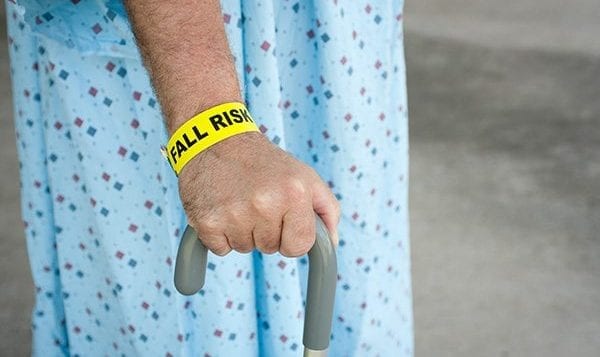Lifestyle changes can reduce your risk
By David Dunaief, M.D.

Aneurysms are universally feared; they can be lethal and most times are asymptomatic (without symptoms). Yet aneurysms are one of the least well-covered medical disorders in the press. There are numerous types of aneurysms, most of which are named by their location of occurrence, including abdominal, thoracic and cerebral (brain). In this article, I will discuss abdominal aortic aneurysms, better known as a “triple-A,” or AAA. Preventing any type of aneurysm should be a priority.
What is an AAA? It is an increase in the diameter of the walls of the aorta in one area, in this case, the abdomen. The aorta is the “water main” for supplying blood to the rest of the body from the heart. Abnormal enlargement weakens the walls and increases the risk that it may rupture. If the aorta ruptures, it causes massive hemorrhaging, or bleeding, and creates a substantial likelihood of death.
The exact incidence of aneurysms is difficult to quantify, since some people may die due to its rupture without having an autopsy; however, estimates suggest that they occur in 4 to 9 percent of the population (1).
The cause of AAA is not known, but it is thought that inflammation and oxidative stress play an important role in weakening smooth muscle in the aorta (2). The consequence of this is an abnormally enlarged aorta.
People who are at highest risk for aneurysms are those over age 60 (3). Other risk factors include atherosclerosis, or hardened arteries; high blood pressure; race (Caucasian); gender (male); family history; smoking; and having a history of aneurysms in other arteries (4). Some of these risk factors are modifiable, such as atherosclerosis, high blood pressure and smoking.
Men are more than four times more likely to have an AAA (5). Though males are at a higher risk, women are at a higher risk of having an AAA rupture (6). So, gender is important for differentiating the incidence, but also the risk of severity.
Is it important to get screened?
The short answer is yes it is important, especially if you have risk factors. You should talk to your physician. Although some people do experience nondescript symptoms, such as pain in the abdomen, back or flank pain, the majority of cases are asymptomatic (4). A smaller AAA is less likely to rupture and can be monitored closely with noninvasive diagnostic tools, such as ultrasound and CT scan.
Sometimes cost is a question when it comes to screening, but a recent study showed unequivocally that screening ultimately reduces cost, because of the number of aneurysms that are identified and potentially prevented from rupturing (7).
What are the treatments?
There are no specific medications that prevent or treat abdominal aortic aneurysms. Medications for treating risk factors, such as high blood pressure, have no direct impact on an aneurysm’s size or progression. But the mainstay of treatment is surgery to prevent rupture. Two surgical techniques may be utilized. One approach is the endovascular repair (EVAR), which is minimally invasive, and the other is the more traditional open surgery (8). A comparison of these approaches in a small randomized controlled trial had similar outcomes: a mortality rate of 25 percent. This was considered a surprisingly good statistic.
The good news is that surgery has resulted in a 29 percent reduction in rupture of the AAA (9). When using the minimally invasive EVAR technique mentioned above, the specialist who performs the surgery may make a difference. A study’s results showed that surgeons had better outcomes, in terms of mortality rates and length of hospital stay, compared to interventional radiologists and cardiologists (10). This was a retrospective (looking in the past) study, which is not the strongest type of trial.
When to watch and wait and when to treat is a difficult question; surgery is not without its complications, and risk of death is higher than many other surgeries. AAA size is the most important factor. In women, AAAs over 5.0 cm may need immediate treatment, while in men, those over 5.5 cm may need immediate treatment (11). Smaller AAAs, however, are trickier.
The growth rate is important, so patients with this type of aneurysm should have an ultrasound or CT scan every six to 12 months. If you have an aneurysm, have a discussion with your physician about this.
Lifestyle changes
One of the most powerful tools against AAA is prevention; it avoids the difficult decision of how to best avoid rupture and the complications of surgery itself. Lifestyle changes are a must. They don’t typically have dangerous side effects, but rather potential side benefits. These lifestyle changes include smoking cessation, exercise and dietary changes.
Smoking cessation

Smoking has the greatest impact because it directly impacts the occurrence and size of an AAA. It increases risk of medium-to-large size aneurysms by at least fivefold. One study found that smoking was responsible for 78 percent of aortic aneurysms larger than 4 cm (12). Remember, size does matter in terms of rupture risk. So for those who smoke, this is a wake-up call.
Impact of fruit
A simple lifestyle modification with significant impact is increasing your fruit intake. The results of two prospective (forward-looking) study populations, Cohort of Swedish Men and the Swedish Mammography Cohort Study, showed that consumption of greater than two servings of fruit a day decreased the risk of an AAA by 25 percent (13). If you do have an AAA, this same amount of fruit also decreased the risk of AAA rupture by 43 percent. This study involved over 80,000 men and women, ages 46 to 84, with a follow-up of 13 years.
The authors believe that fruit’s impact may have to do with its antioxidant properties; it may reduce the oxidative stress that can cause these types of aneurysms. Remember, the quandary has been when the benefit of surgery outweighs the risks, in terms of preventing rupture. This modest amount of fruit on a daily basis may help alleviate this quandary.
So what have we learned? Screening for AAA may be very important, especially as we age and if we have a family history. Surgery results to prevent rupture are similar, regardless of the type. However, keep in mind that surgery for AAA has a significant mortality risk. At the end of the day, lifestyle changes, including smoking cessation and increased fruit intake, are no-brainers.
References: (1) Ann Intern Med. 2001;134(3):182. (2) Arterioscler Thromb Vasc Biol. 2007;27:461–469. (3) J Vasc Surg. 1999;30(6):1099. (4) uptodate.com. (5) Arch Intern Med. 2000;160(10):1425. (6) J Vasc Surg. 2006;43(2):230. (7) 2012 BMJ Publishing Group. (8) Ann Surg. 2013 online Apr 1. (9) J Vasc Surg. 2009;49(3):543. (10) Annals of Surgery. 2013;258(3):476-482. (11) Lancet. 1998;352(9141):1649. (12) Ann Intern Med. 1997;126(6):441. (13) Circulation. 2013;128:795-802.
Dr. Dunaief is a speaker, author and local lifestyle medicine physician focusing on the integration of medicine, nutrition, fitness and stress management. For further information, visit www.medicalcompassmd.com or consult your personal physician.

























